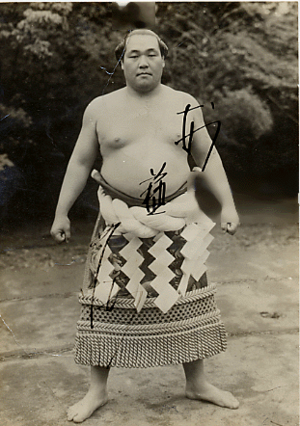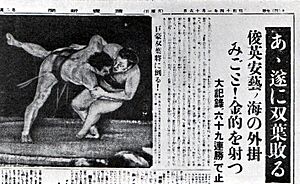Akinoumi Setsuo facts for kids
Quick facts for kids 安藝ノ海 節男Akinoumi Setsuo |
|
|---|---|

Script error: The function "getImageLegend" does not exist.
|
|
| Personal information | |
| Born | Nagata Setsuo May 30, 1914 Hiroshima, Japan |
| Died | March 25, 1979 (aged 64) |
| Height | 1.77 m (5 ft 9+1⁄2 in) |
| Weight | 127.5 kg (281 lb) |
| Career | |
| Stable | Dewanoumi |
| Record | 209–101–38 |
| Debut | February 1932 |
| Highest rank | Yokozuna (May 1942) |
| Retired | November, 1946 |
| Elder name | Fujishima |
| Championships | 1 (Makuuchi) 1 (Jonokuchi) |
| Gold Stars | 1 (Futabayama) |
| * Up to date as of June 2020. | |
Akinoumi Setsuo (Japanese: 安藝ノ海 節男, Hepburn: Akinoumi Setsuo, May 30, 1914 – March 25, 1979), born Nagata Setsuo (永田 節男), was a famous Japanese professional sumo wrestler. He came from Hiroshima, Japan. Akinoumi was a very special wrestler. He became the 37th yokozuna, which is the highest rank in sumo.
Contents
Akinoumi's Sumo Career
Akinoumi started his sumo career in February 1932. He quickly moved up the ranks. By January 1938, he reached the top makuuchi division. This is where the best sumo wrestlers compete.
Ending a Winning Streak
One of Akinoumi's most famous moments happened in January 1939. He faced Futabayama, a legendary yokozuna. Futabayama had won an amazing 69 matches in a row! Akinoumi, who was a lower-ranked maegashira at the time, defeated him. This was a huge surprise and a massive upset in the sumo world. He won by using a move called sotogake, which is an outer leg trip.
Becoming a Champion
Akinoumi won his only top division championship in May 1940. At that time, he was ranked as a sekiwake. In 1941, he was promoted to ōzeki. This was a big deal because no wrestler from Hiroshima Prefecture had reached this rank in 127 years!
Reaching Yokozuna Rank
Akinoumi became a yokozuna in May 1942. He earned this top rank after two strong performances. He won 13 matches and lost only two in each tournament. He was promoted at the same time as another wrestler named Terukuni. Even though he was a yokozuna, he is often remembered more for beating Futabayama. He was a yokozuna for eight tournaments but did not win any more championships.
Life After Sumo
Akinoumi retired from sumo in November 1946. After retiring, he became an elder of the Japan Sumo Association. This meant he could stay involved in the sumo world. His elder name was Fujishima.
He later left the sumo world in January 1955. After that, he tried different jobs. He ran a chanko restaurant, which serves a special stew popular with sumo wrestlers. When that business closed, he opened a clothing store. He also worked as a sumo commentator on TV.
Akinoumi turned 60 years old in 1974. Usually, yokozuna celebrate this with a special ceremony called kanreki dohyō-iri. However, for reasons that are not clear, he did not get to perform this ceremony. He passed away in 1979 due to health problems.
Images for kids
See also
- Glossary of sumo terms
- List of past sumo wrestlers
- List of sumo tournament top division champions
- List of yokozuna



